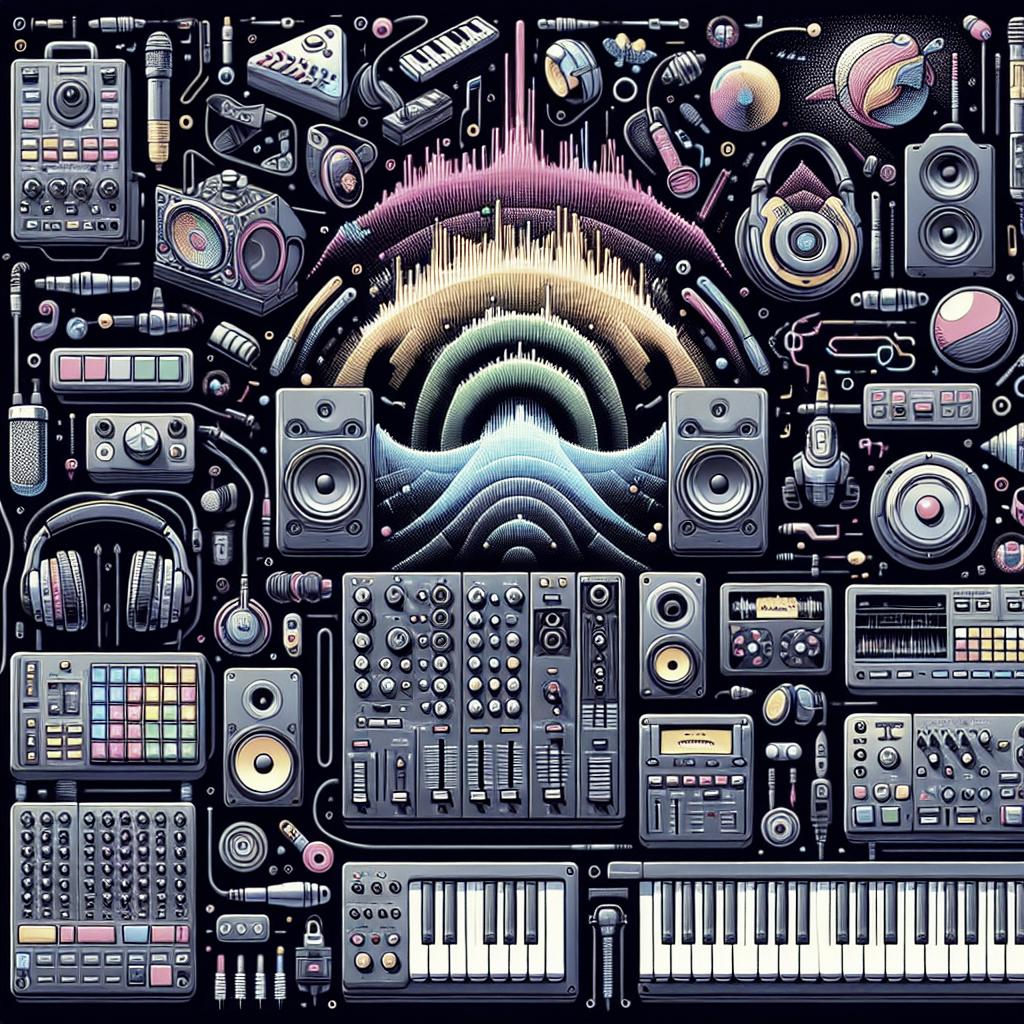<>
Starting an electronic music blog can be an incredibly rewarding endeavor, whether you’re a seasoned music aficionado or just starting your journey into the vibrant world of electronic beats and synths. This blog post will guide you through the entire process, from the initial planning stages to monetization strategies. We’ll cover why you might want to start a music blog, how to plan and set up your blog, and delve into the nitty-gritty of content strategy and design customization. By the end of this post, you’ll be well-equipped with the knowledge and confidence to launch a successful electronic music blog that resonates with your audience.
Why Would You Want to Start a Music Blog?
Starting a music blog, especially one focused on electronic music, allows you to share your passion with a broader audience. It serves as a platform to express your thoughts, insights, and discoveries in the ever-evolving world of electronic music. Moreover, it offers an avenue to connect with like-minded enthusiasts, create a personal brand, and establish yourself as an authority in the genre. Additionally, a music blog opens doors to numerous opportunities, such as networking with artists, attending events as press, and even monetizing your content. Whether you aim to make a professional career out of it or simply want a creative outlet, the benefits of starting a music blog are manifold.
How to Start Planning Your Music Blog
1. Determine What Types of Music You Will Cover
The realm of electronic music is vast, encompassing various sub-genres such as house, techno, trance, dubstep, and more. Deciding on the specific types of music you will cover is crucial. It’s essential to identify your personal interests and expertise to ensure authenticity and passion in your content. Additionally, consider your target audience and what sub-genres are currently trending. Specializing in a particular niche can help you stand out in the crowded blogosphere. For instance, focusing on underground techno or emerging electronic artists can attract a dedicated readership and foster a loyal community.
2. Decide if This Will Be a Hobby or Something You Want to Monetize
Clarifying your blog’s purpose early on is vital. If your blog is a hobby, your primary goal may be to share your love for electronic music without the pressure of generating revenue. However, if monetization is your goal, you’ll need to approach your blog with a more strategic mindset, focusing on content that attracts traffic and engages readers. Monetized blogs often require investment in marketing, SEO, and perhaps even paid collaborations. It’s essential to weigh your time, resources, and long-term goals to determine the best approach for your blog.
3. Decide if This Will Be a Solo Blog or if You’ll Recruit Editors and Writers to Contribute
Running a blog solo can be incredibly gratifying, but it can also be time-consuming and demanding. If you’re comfortable wearing multiple hats—from writing and editing to marketing and social media management—then a solo blog might be for you. Alternatively, recruiting editors and writers can enhance the diversity and quality of your content. Collaborative blogs can cover a broader range of topics and perspectives, making your blog a more comprehensive resource for readers. Plus, it can alleviate some workload, allowing you to focus on other aspects of blog management.
4. Decide if You’ll Have a Local, Regional, National, or International Focus in Your Coverage
Geographical focus can significantly influence your blog’s scope and audience. A local or regional blog might concentrate on events, artists, and venues specific to your area. This approach can build a loyal, engaged readership with a community-centric angle. On the other hand, a national or international focus allows you to cover a wider range of topics, artists, and trends. This broader approach can attract a diverse, global audience but may require more extensive research and networking to stay up-to-date with international scenes.
5. Come Up With a Name for Your Blog
Your blog’s name is the first impression and should reflect its content and ethos. It should be memorable, easy to spell, and ideally give a hint about the type of music you cover. Brainstorming sessions with friends or fellow music enthusiasts can generate creative ideas. Check the availability of your chosen blog name as a domain. Consistency across your blog’s name, domain, and social media handles can establish a strong, cohesive brand presence.
Put Together a Basic Content Strategy
Content Formats
A successful blog features diverse content formats to cater to varying reader preferences. Consider incorporating articles, interviews, album reviews, event coverage, and industry news. Each format offers unique value, from deep analytical pieces to quick, engaging updates. Video and audio content, like podcasts and vlogs, can further enhance your blog’s appeal. They provide a more dynamic and interactive experience, keeping your audience engaged.
Content Type
Determine the primary types of content your blog will feature. Will you focus on artist spotlight interviews, album and track reviews, or maybe industry news and tech innovations? Your choice should align with your expertise and audience interests. A balance between evergreen content and timely posts can help your blog attract and retain readers. Evergreen content, such as how-to guides and historical pieces, remains relevant over time, while timely posts capture current trends and events.
Voice and Tone
Your blog’s voice and tone should reflect your personality and the culture of electronic music. Decide whether you’ll adopt a formal, authoritative tone or a more casual, conversational style. Consistency in voice helps in building a recognizable brand and connecting with your audience. Engaging language and enthusiasm can make technical topics more accessible and exciting. Ultimately, your voice should resonate with both you and your readers, fostering an authentic connection.
Setting Up Your Music Blog
1. Choose Between WordPress.com or WordPress.org
WordPress.com offers a fully hosted solution, ideal for beginners who want a straightforward setup without worrying about hosting and maintenance. It’s a great choice if you want to focus purely on content creation. Conversely, WordPress.org requires self-hosting, providing more flexibility and control over your site. It’s perfect for those willing to invest time in technical setup and customization. The choice depends on your technical comfort level and customization needs.
2. Choose Your Domain Name
Your domain name should align with your blog’s name and be easy to remember and spell. Check for availability and choose a reputable registrar to purchase it. A good domain name boosts your blog’s professionalism and discoverability. Consider using keywords relevant to electronic music in your domain name to enhance SEO and make your blog more identifiable to new readers.
3. Choose a Theme
Your blog’s theme should reflect your content’s style and your personal aesthetic. WordPress offers a plethora of free and premium themes. Choose one that is clean, responsive, and easy to navigate. A well-designed theme enhances user experience and keeps readers engaged. Ensure it’s mobile-friendly as a significant portion of readers may access your blog via smartphones.
3. Choose Plugins (if you have the Business plan)
Plugins can add functionality to your WordPress site. Essential plugins for a music blog might include Yoast SEO for search optimization, Jetpack for site security and performance, and Google Analytics for tracking visitor behavior. Exploring specific music-related plugins, such as Soundcloud Embed and GigPress, can enhance your blog’s multimedia experience. Choose plugins that align with your needs but avoid overloading your site, which can hamper performance.
4. Choose Categories
Organizing your content into categories makes it easier for readers to find their interests and provides a clear structure for your blog. Think about major themes or recurring topics in electronic music you plan to cover. Categories might include genres, artist profiles, industry news, events, and reviews. Gradually, you can refine and expand upon these as your blog grows and evolves.
5. Add Essential Pages
Essential pages like About, Contact, and Privacy Policy provide crucial information about your blog and enhance transparency and trust. An About page introduces you and explains the blog’s mission, while a Contact page enables reader engagement. Including a Privacy Policy is necessary for legal compliance, especially if you plan to collect data from your users. These pages contribute to building a reliable and professional online presence.
6. Add Users To Your Website
If you decide to collaborate, adding users to your website with specified roles can streamline workflow. Assigning roles like Editor, Author, or Contributor helps manage responsibilities and permissions effectively. Clearly defined roles ensure that each team member understands their tasks and contributions, fostering a cohesive and efficient working environment.
7. Create a Menu
A well-organized menu enhances user experience by making navigation intuitive. Include essential pages and major categories in the main menu for easy access. Consider adding a secondary menu for less prominent links, ensuring your layout remains clean and uncluttered. Regularly update the menu as you add new content to keep it relevant.
Designing and Customizing Your Music Blog
1. Learn Your Way Around the Site Editor
Familiarizing yourself with the site editor is crucial for effective customization. WordPress’s Gutenberg editor offers a block-based interface that’s user-friendly and highly customizable. Spend time learning how to use different blocks, such as text, images, and embeds, to create visually appealing posts and pages. A good grasp of the editor enables you to bring your creative vision to life.
2. Use Styles to Edit Colors, Fonts, and More
Customizing styles allows you to maintain a consistent and visually appealing brand aesthetic. Edit colors, fonts, and other design elements to align with your blog’s personality and the electronic music theme. Consistency in styling creates a professional look and feel, making your blog more memorable and engaging to readers. Experiment with different options to find what resonates best.
3. Add a Homepage Header
A captivating homepage header can significantly impact first impressions. Use high-quality images, intriguing text, or even multimedia elements to create an eye-catching header. Your header should immediately convey the essence of your blog and entice visitors to explore further. Keep it updated with fresh content to maintain interest and relevance.
Running Your Music Blog
Decide on Publishing Frequency
Consistent publishing schedules build reader expectations and loyalty. Decide on a realistic frequency that balances quality and consistency—whether it’s weekly, bi-weekly, or monthly posts. Regular content updates keep your blog active and engaging, encouraging repeat visits and improved SEO performance.
Promote Your Blog
Promotion is key to growing your readership. Utilize social media platforms like Facebook, Twitter, and Instagram to share your content and engage with the electronic music community. Consider other promotional avenues such as guest posting, email newsletters, and collaborations with other bloggers. Diverse promotional strategies can significantly boost your blog’s visibility.
Measure Performance
Analyzing your blog’s performance helps identify what works and areas for improvement. Tools like Google Analytics and WordPress stats provide valuable insights into traffic, reader behavior, and popular content. Regular performance reviews enable data-driven decisions to enhance your blog’s effectiveness, drive engagement, and achieve your long-term goals.
How to Monetize Your Music Blog
1. Payments Block or Donations Block
Adding a payments or donations block can generate income from loyal readers who appreciate your content. Clearly explain how the contributions will support and improve your blog. Transparency and gratitude foster trust and encourage donations. Offer special perks or content for donors to incentivize their support.
2. Add a Merch Store with WooCommerce
Selling merchandise related to electronic music or your blog’s brand can be a lucrative monetization strategy. Use WooCommerce to set up an easy-to-navigate online store. Merchandise options could include apparel, accessories, or even digital downloads like exclusive mixes. Quality products enhance your brand and provide additional revenue streams.
3. Patreon
Creating a Patreon account allows fans to support your blog through subscription-based funding. Offer tiered memberships with exclusive content, early access, or behind-the-scenes insights to entice supporters. Personalized engagement and rewards foster a strong community and can significantly boost your income while maintaining reader loyalty.
4. Add Subscriber/Membership Options
Implementing subscription or membership options provides a steady income stream. Offer premium content, ad-free experiences, or direct interaction with you as incentives for membership. Balancing free and exclusive content ensures broad accessibility while rewarding dedicated readers, enhancing both readership and revenue.
Ready to Start Your Music Blog?
Share this:
Leverage social media channels and encourage readers to share your content. Utilize sharing plugins to facilitate easy sharing across various platforms, broadening your reach. Building a community around your blog through enthusiastic sharing and engagement creates a vibrant, interactive space for electronic music lovers.
Related
Regularly update your blog with related posts to keep readers engaged. Link to other relevant content to encourage deeper exploration of your site, enhancing time spent on your blog. Curating related content helps retain readers and fosters a comprehensive resource hub for electronic music enthusiasts.
Let Our Experts Build Your Custom WordPress.com Website
If you find the process overwhelming or wish to focus more on content than technical setup, consider hiring experts. Professional help can streamline the setup and customization process, ensuring a polished, professional look from the start.
| Section | Key Points |
|---|---|
| Why Start a Music Blog? | Share passion, connect with community, potential for monetization and opportunities. |
| Planning Your Blog | Determine music types, hobby vs. monetization, solo vs. collaborative, geographical focus, name your blog. |
| Content Strategy | Content formats, types, voice and tone. |
| Setting Up Your Blog | WordPress choice, domain, theme, plugins, categories, essential pages, user roles, menu. |
| Designing and Customizing | Site editor, styles, homepage header. |
| Running Your Blog | Publishing frequency, promoting blog, performance measurement. |
| Monetizing Your Blog | Payments and donations, merch store, Patreon, subscriptions/memberships. |


